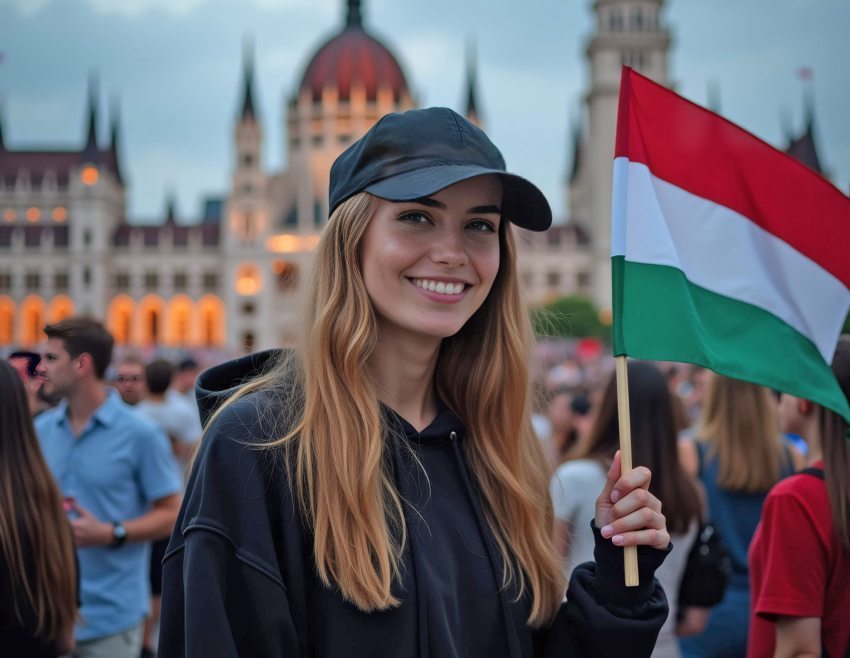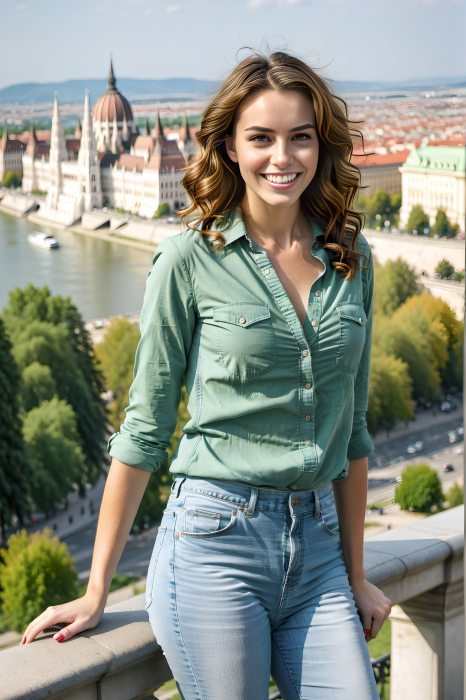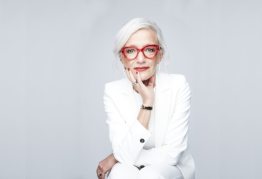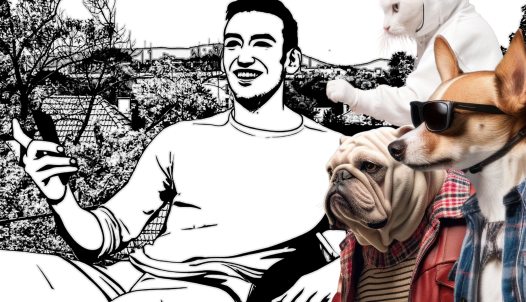The first AI anchorwoman in Hungarian media history has even been asked out on a date
Many people still have concerns about artificial intelligence and see it as a threat. However, Ada Bíró, the anchor of the television show Delta, proves that technological development has a lot of benefits, and it can be used to communicate values or even for other, good causes, just like the ones she is a part of. We talked about Ada with producer Ernő Urbán, the managing director of ERLA TECHNOPRO KFT, and his colleague, Gábor Rácz, who is the project manager of the Delta TV program.

When Ada Bíró first appeared as a newsanchor she said that her existence was a trade secret. What can we still know about her?
Gábor Rácz: We developed Ada with our colleagues using a combination of language and video models. In addition to the existing software, we also used our own developments to implement the best solutions both visually and audially, the latter being a trade secret.
Was Ada modelled on a specific person?
Ernő Urbán: Ada's look was created with the help of a team of graphic designers. We didn't want her to resemble anyone else, but if she does, it's by accident. But her name is inspired by Ada Lovelace (born Ada Byron), an English mathematician and writer, most famous for writing the specification for the first mechanical computer, the analytical calculator, designed by Charles Babbage. Some say that she also wrote the programs for the machine, making her the first computer programmer.
What is the purpose of Ada's appearance?
Ernő Urbán: In a tv programme that is about science and the latest innovations, introducing technical innovations that are already part of our everyday lives is absolutely right.
We do not see Ada as an object, but as a colleague. We want to build her up as a helpful person with a very positive attitude. She will represent issues in the future, and is doing so now, that have serious value.
Is Ada able to speak independently or does someone else write her lines?
Ernő Urbán: Ada is a visual and linguistic model. With the help of ChatGPT, she is able to answer the questions herself, but this technique is not yet so well developed. Our goal is to make sure that Ada only says things that are not objectionable, legally correct and fit her personality, so we have a team of editors behind her.
How has she been received by the Hungarian audience?
Gábor Rácz: Most people see the technical novelty, are open to it, and we get a lot of positive feedback. Some people are interested, but still prefer to keep their distance from AI. There are also those who take a very radical view of Ada: take her off the screen, turn her off, there is no need for her. We also accept and understand these opinions. There is also a small group of people who see her as a human being, who court her, compliment her, ask her out, even though we have never once in a single sentence said that she is a real person. She even says in every single show that she is an AI avatar.
Ernő Urbán: Whatever the topic, people can have very extreme opinions. Those who have tried to do something similar, and know that Ada is connected to us, genuinely bow their heads to us, I can say that without modesty. Ada is a visual and linguistic model, in fact a cartoon character who has been brilliantly drawn. She is fantastically skilful, but only within certain limits.
Ada is similar to when you press a button on your phone and a voice reads your message, only she has a face.
Ada has received a lot of criticism since she first appeared: her voice is mechanical, her gestures are not in line with her speech, etc. What do you think about these? Can you change these?
Gábor Rácz: These criticisms are absolutely valid, we don't feel offended by them, because we can see all this too. When we introduced Ada, we did not say that she was human. She will not have the independence, the uniqueness, the magical personality that a human being has, for a long time. People who have not been involved in this field and just use ChatGPT think that everything happens by magic, but there is a lot of work behind it. This industry is constantly evolving, with a lot of new things being created every day. We monitor these and work to correct the audio and visual problems that we discover. But there is a certain level that we cannot yet cross.
Ernő Urbán: There's a big difference between the Ada who appeared in the first show and the current one, she's learning her role. As Hungarian is not a language that software developers have developed for, it is a challenge to get a character to speak in Hungarian, an English-speaking model is always more advanced. Ada's speech has improved a lot compared to the first shows. We can hear that she sometimes makes mistakes, but she speaks very well in Hungarian, and we are leading the way in this area in Hungary. The lip-sync is not perfect yet, but we are working on matching the mouth movements to the voices even better, and also on controlling her movements even better in this kind of visual quality. There are still serious limitations in this field, but who knows where we will get tomorrow or the day after. On the outside, everything looks simple, but there are huge capacities and long strings of programmes behind it.
The only thing that will not change is Ada's appearance. Her skin, hair, make-up and clothes will be the same in 10 years. This is our firm decision, because by doing so we want to show that she is not human.
Ada has also been criticised for taking someone else's job.
Ernő Urbán: I don't think so. It is true that artificial intelligence will completely transform the labour market, creating new jobs and eliminating old ones, in the same way that machins have transformed industry. I encourage everyone to get to know this technology, because it is coming at us at light speed, and it is already here, whether as Ada, predictive text input or Facebook's algorithm. Anyone who is open to it, who knows this technology, will have a head start in the competition, regardless of age. If people use AI well, it's a very good thing. We have a huge responsibility in what we put behind the face, what messages we convey through it.
Ada has her own Facebook profile and even gives interviews. Why do you need this if you don't want to give the impression that she's a real person?
Gábor Rácz: We just want to increase her popularity and take advantage of the opportunities offered by social media. We're always trying to show something interesting about her: how her character is created, how we're developing and refining her. Plus, as I've already mentioned, she gives her face to important issues that are of value.
There are AI news anchors in other countries too. How is Ada different? In what way is she a novelty?
Gábor Rácz:
When we created Ada, we didn't want her to be the animated character we know from social media, but to have a photo-realistic look that would be more in line with television and make the visuals of the show more balanced.
We have not met a character yet who has an independent role in a popular science television program.
Ernő Urbán: In Europe, there's one character other than Ada who works as a newscaster, but doesn't look as good. China and Japan are much further ahead in this area, but they have different legislation. Last weekend we were in Amsterdam at the International Television Showcase, where we tested Ada's character and graphic design. We ourselves were surprised how far ahead of our colleagues we were, we hadn't seen such an elaborate, photo-realistic character or similar solutions.
Is it possible that other shows will feature presenters created by artificial intelligence? Will Ada get another show or a co-host?
Gábor Rácz: We have another avatar in the box, but we don't use it, we haven't incorporated it into another show yet. We still have plenty to do with Ada, so there's no point talking about anything else for now.
Ernő Urbán: We are planning to include Ada in other programmes, for example, we are now working on her being able to help people with disabilities, to act as a permanent sign interpreter. We are not thinking about a co-host at the moment, although technology is developing so fast that we don't know what tomorrow will bring. At the moment, our aim is to build her character as much as possible, to make her known, to get people to accept her as much as possible, to understand the phenomenon she represents and to find out how they can benefit from this technology.
What new features can we expect in the near future?
Gábor Rácz: Ada is improving day by day. Today, one of our developer colleagues exclaimed that he had finally managed to change the background image and Ada's body so that the latter became transparent, and so the background could change in a different way. It's seemingly a small thing that many viewers won't even notice, but it's a lot of work. We want to recreate Ada's character as accurately and beautifully as possible. We keep people updated on these developments on the various platforms.
We can say that we use Ada to promote knowledge about artificial intelligence through a character.
We also want Ada to help on all fronts, not only with her technical knowledge, but also by suggesting a solution, as she does in the recent video on food waste. She not only gives us specific numbers and tells us how damaging it is to our planet and to humanity, but also gives us specific advice on what we can do differently, how we can save.









